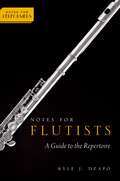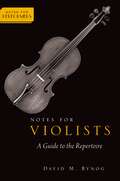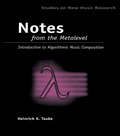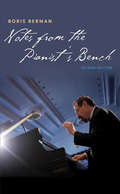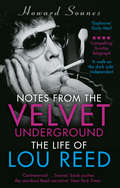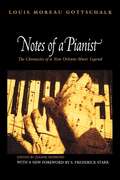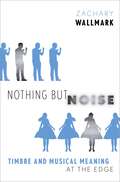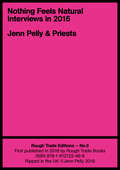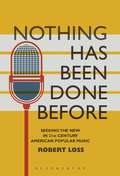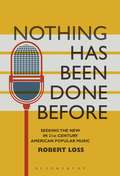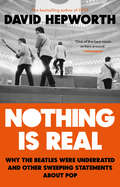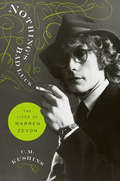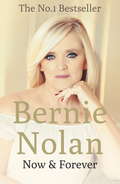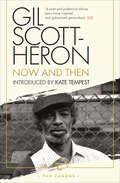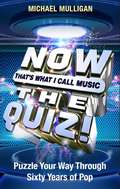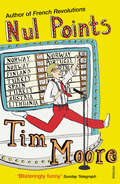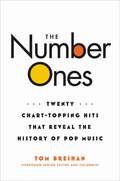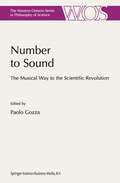- Table View
- List View
Notes for Flutists: A Guide to the Repertoire (Notes for Performers)
by Dr. Kyle DzapoNotes for Flutists: A Guide to the Repertoire offers important historical and analytical information about three dozen of the best-known pieces written for the instrument. Its contextual and theoretical insights make it an essential resource for professional, amateur, and student flutists. With engaging prose supported by fact-filled analytical charts, the book offers rich biographical information and informative analyses to help flutists gain a more complete understanding of J. S. Bach's Sonata in B minor, Reinecke's Undine Sonata, Fauré's Fantaisie, Hindemith's Sonata for Flute and Piano, Copland's Duo for Flute and Piano, and 30 other masterpieces. Offering a faithful and comprehensive guide to understanding the contexts in which the repertoire was composed, Notes for Flutists details in clear, chronological order flute repertoire from Telemann, Mozart, and Enescu to Prokofiev, Poulenc, and Muczynski. Kyle Dzapo includes biographical information on each composer and highlights history's impact on the creation and performance of important works for flute. Intended as a starting point for connecting performance studies with scholarship, Dr. Dzapo's analysis will help flutists gain a more complete picture of a given work. Its valuable insights make it essential to musicians preparing and presenting programs, and its detailed historical information about the work and composer will encourage readers to explore other works in a similarly analytical way. Covering concertos, chamber pieces, and works for solo flute, Kyle Dzapo presents Notes for Flutists, an indispensable handbook for students and professionals alike.
Notes for Flutists: A Guide to the Repertoire (Notes for Performers)
by Dr. Kyle DzapoNotes for Flutists: A Guide to the Repertoire offers important historical and analytical information about three dozen of the best-known pieces written for the instrument. Its contextual and theoretical insights make it an essential resource for professional, amateur, and student flutists. With engaging prose supported by fact-filled analytical charts, the book offers rich biographical information and informative analyses to help flutists gain a more complete understanding of J. S. Bach's Sonata in B minor, Reinecke's Undine Sonata, Fauré's Fantaisie, Hindemith's Sonata for Flute and Piano, Copland's Duo for Flute and Piano, and 30 other masterpieces. Offering a faithful and comprehensive guide to understanding the contexts in which the repertoire was composed, Notes for Flutists details in clear, chronological order flute repertoire from Telemann, Mozart, and Enescu to Prokofiev, Poulenc, and Muczynski. Kyle Dzapo includes biographical information on each composer and highlights history's impact on the creation and performance of important works for flute. Intended as a starting point for connecting performance studies with scholarship, Dr. Dzapo's analysis will help flutists gain a more complete picture of a given work. Its valuable insights make it essential to musicians preparing and presenting programs, and its detailed historical information about the work and composer will encourage readers to explore other works in a similarly analytical way. Covering concertos, chamber pieces, and works for solo flute, Kyle Dzapo presents Notes for Flutists, an indispensable handbook for students and professionals alike.
Notes for Violists: A Guide to the Repertoire (Notes for Performers)
by David M. BynogNotes for Violists: A Guide to the Repertoire offers historical and analytical information about thirty-five of the best-known pieces for the instrument, making it an essential resource for professional, amateur, and student violists alike. With engaging prose supported by fact-filled analytical charts, the book offers rich biographical information and insightful analyses that help violists gain a more complete understanding of pieces like Béla Bartók's Concerto for Viola and Orchestra, Rebecca Clarke's Sonata for Viola and Piano, Robert Schumann's Märchenbilder for Viola and Piano, op. 113, Carl Stamitz's Concerto for Viola and Orchestra in D Major, Igor Stravinsky's Élégie for Viola or Violin Unaccompanied, and thirty other masterpieces. This comprehensive guide to key pieces from the viola repertoire from the eighteenth through the twentieth century covers concertos, chamber pieces, and works for solo viola by a wide range of composers, including Bach, Telemann, Mozart, Hoffmeister, Walton, and Hindemith. Author David M. Bynog not only offers clear structural analyses of these compositions but also situates them in their historical contexts as he highlights crucial biographical information on composers and explores the circumstances of the development and performance of each work. By connecting performance studies with scholarship, this indispensable handbook for students and professionals allows readers to gain a more complete picture of each work and encourages them to approach other compositions in a similarly analytical manner.
Notes for Violists: A Guide to the Repertoire (Notes for Performers)
by David M. BynogNotes for Violists: A Guide to the Repertoire offers historical and analytical information about thirty-five of the best-known pieces for the instrument, making it an essential resource for professional, amateur, and student violists alike. With engaging prose supported by fact-filled analytical charts, the book offers rich biographical information and insightful analyses that help violists gain a more complete understanding of pieces like Béla Bartók's Concerto for Viola and Orchestra, Rebecca Clarke's Sonata for Viola and Piano, Robert Schumann's Märchenbilder for Viola and Piano, op. 113, Carl Stamitz's Concerto for Viola and Orchestra in D Major, Igor Stravinsky's Élégie for Viola or Violin Unaccompanied, and thirty other masterpieces. This comprehensive guide to key pieces from the viola repertoire from the eighteenth through the twentieth century covers concertos, chamber pieces, and works for solo viola by a wide range of composers, including Bach, Telemann, Mozart, Hoffmeister, Walton, and Hindemith. Author David M. Bynog not only offers clear structural analyses of these compositions but also situates them in their historical contexts as he highlights crucial biographical information on composers and explores the circumstances of the development and performance of each work. By connecting performance studies with scholarship, this indispensable handbook for students and professionals allows readers to gain a more complete picture of each work and encourages them to approach other compositions in a similarly analytical manner.
Notes from the Metalevel: An Introduction to Computer Composition
by Heinrich TaubeFirst Published in 2005. Routledge is an imprint of Taylor & Francis, an informa company.
Notes from the Metalevel: An Introduction to Computer Composition
by Heinrich TaubeFirst Published in 2005. Routledge is an imprint of Taylor & Francis, an informa company.
Notes from the Pianist's Bench: Second Edition, Multimedia Edition
by Boris BermanA master class on piano performance and pedagogy from the world-renowned concert pianist In this newly revised edition of a comprehensive guide to piano technique, performance, and music interpretation, renowned performing musician, recording artist, and teacher Boris Berman addresses virtually every aspect of musical artistry and pedagogy. Ranging from such practical matters as sound, touch, and pedaling to the psychology of performing and teaching, this essential volume provides a master class for the performer, instructor, and student alike. It is also available as a multimedia e-Book.
Notes from the Velvet Underground: The Life of Lou Reed
by Howard Sounes**** COMPELLING - The Sunday TelegraphCONTROVERSIAL ... Sounes' book pushes the standard Reed narrative - The New York TimesLou Reed, who died in 2013, was best known to the general public as the grumpy New Yorker in black who sang 'Walk on the Wild Side'. To his dedicated admirers, however, he was one of the most innovative and intelligent American songwriters of modern times, a natural outsider who lived a tumultuous and tortured life.In this in-depth, meticulously researched and very entertaining biography, respected biographer Howard Sounes examines the life and work of this fascinating man, from birth to death, including his time as the leader of The Velvet Underground - one of the most important bands in rock'n'roll.Written with a deep knowledge and understanding of the music, Sounes also sheds entirely new light on the artist's creative process, his mental health problems, his bisexuality, his three marriages, and his addictions to drugs and alcohol.In the course of his research, Sounes has interviewed over 140 people from every part of Lou Reed's life - some of whom have not spoken publicly about him before - including music industry figures, band members, fellow celebrities, family members, former wives and lovers.This book brings Lou Reed and his world alive.
Notes of a Pianist
by Louis Moreau Gottschalk Jeanne Behrend Frederick S. StarrNotes of a Pianist chronicles the life of one of the most remarkable musical minds of the American experience, the great nineteenth-century New Orleans-born composer and pianist Louis Moreau Gottschalk (1829-1869). An important cultural and historical work, the book recounts Gottschalk's experiences as he traveled and performed throughout the last decade of his life. Born to an English-Jewish father and a Haitian mother, Gottschalk is remembered as one of the great New Orleans musicians and composers, his music a combination of the classical tradition in which he was trained, and the New Orleans tradition into which he was born. His art form took him far outside the boundaries of Louisiana, however. While still a child, he studied piano in Paris and gave a concert at the Salle Pleyel, after which Frédéric Chopin is said to have remarked: "Give me your hand, my child; I predict that you will become the king of pianists." Gottschalk returned to the United States in 1853, and later lived in Cuba, Puerto Rico, Panama, and South America, during which time he kept-sometimes sporadically, sometimes daily--the notebooks that formed the basis of Notes of a Pianist. Published for the first time in 1881, the book continues to resonate with American cultural and musical life. Notes of a Pianist demonstrates Gottschalk's importance not only as a reporter of the musical life and tastes of Americans during the Civil War, but also as a forefather of Louisiana's rich musical culture.
Nothing but Noise: Timbre and Musical Meaning at the Edge
by Zachary WallmarkNothing but Noise: Timbre and Musical Meaning at the Edge explores how timbre shapes musical affect and meaning. Integrating perspectives from musicology with the cognitive sciences, author Zachary Wallmark advances a novel model of timbre interpretation that takes into account the bodily, sensorimotor dynamics of sound production and perception. The contribution of timbre to musical experience is clearest in drastic situations where meaning is itself contested; that is, in polarizing contexts of reception where evaluation of "musical" timbre by some listeners collides headlong against a competing claim-that it is just "noise." Taking this ubiquitous moment as a starting point, the book explores affect, reception, and timbre semantics through diverse cultural-historical case studies that frustrate the acoustic and perceptual boundary between musical sound and noise. Nothing but Noise includes chapters on the racial and gender politics in the reception of free jazz saxophone "screaming" in the late 1960s; an analysis of contested timbral ideals in the performance practices of the Japanese shakuhachi flute; and an historical examination of the overlooked role of "brutal" timbres in the moral panic over heavy metal in the eighties and nineties. The book closes with a discussion of the slippery social fault lines separating perceptions of musical sound from noise and the ethical stakes of encountering another's "aural face."
Nothing but Noise: Timbre and Musical Meaning at the Edge
by Zachary WallmarkNothing but Noise: Timbre and Musical Meaning at the Edge explores how timbre shapes musical affect and meaning. Integrating perspectives from musicology with the cognitive sciences, author Zachary Wallmark advances a novel model of timbre interpretation that takes into account the bodily, sensorimotor dynamics of sound production and perception. The contribution of timbre to musical experience is clearest in drastic situations where meaning is itself contested; that is, in polarizing contexts of reception where evaluation of "musical" timbre by some listeners collides headlong against a competing claim-that it is just "noise." Taking this ubiquitous moment as a starting point, the book explores affect, reception, and timbre semantics through diverse cultural-historical case studies that frustrate the acoustic and perceptual boundary between musical sound and noise. Nothing but Noise includes chapters on the racial and gender politics in the reception of free jazz saxophone "screaming" in the late 1960s; an analysis of contested timbral ideals in the performance practices of the Japanese shakuhachi flute; and an historical examination of the overlooked role of "brutal" timbres in the moral panic over heavy metal in the eighties and nineties. The book closes with a discussion of the slippery social fault lines separating perceptions of musical sound from noise and the ethical stakes of encountering another's "aural face."
Nothing Feels Natural: Interviews in 2016 (Rough Trade Edition)
by Jenn Pelly PriestsNothing Feels Natural is an abridged editions of the zine that originally accompanied Priests' debut LP of the same name in 2017. It features a series of interviews conducted with the band by journalist Jenn Pelly in Washington, DC during the first days of November 2016.
Nothing Has Been Done Before: Seeking The New In 21st-century American Popular Music (Alternate Takes: Critical Responses To Popular Music Ser.)
by Professor Robert LossIs there such a thing today as music that's meaningfully new? In our contemporary era of remixing and retro styles, cynics and romantics alike cry "It's all been done before" while record labels and media outlets proclaim that everything is new. Coded into our daily conversations about popular music, newness as an artistic and cultural value is too often taken for granted.Nothing Has Been Done Before instigates a fresh debate about newness in American pop, rock 'n' roll, rap, folk, and R&B made since the turn of the millennium. Utilizing an interdisciplinary approach that combines music criticism, philosophy, and the literary essay, Robert Loss follows the stories of a diverse cast of musicians who seek the new by wrestling with the past, navigating the market, and speaking politically. The transgressions of Bob Dylan's "Love and Theft". The pop spectacle of Katy Perry's 2015 Super Bowl halftime show. Protest songs against the war in Iraq. Nothing Has Been Done Before argues that performance heard in a historical context always creates a possibility for newness, whether it's Kendrick Lamar's multi-layered To Pimp a Butterfly, the Afrofuturist visions of Janelle Monáe, or even a Guided By Voices tribute concert in a local dive bar. Provocative and engaging, Nothing Has Been Done Before challenges nothing less than how we hear and think about popular music-its power and its potential.
Nothing Has Been Done Before: Seeking the New in 21st-Century American Popular Music (Alternate Takes: Critical Responses to Popular Music)
by Robert LossIs there such a thing today as music that's meaningfully new? In our contemporary era of remixing and retro styles, cynics and romantics alike cry "It's all been done before" while record labels and media outlets proclaim that everything is new. Coded into our daily conversations about popular music, newness as an artistic and cultural value is too often taken for granted.Nothing Has Been Done Before instigates a fresh debate about newness in American pop, rock 'n' roll, rap, folk, and R&B made since the turn of the millennium. Utilizing an interdisciplinary approach that combines music criticism, philosophy, and the literary essay, Robert Loss follows the stories of a diverse cast of musicians who seek the new by wrestling with the past, navigating the market, and speaking politically. The transgressions of Bob Dylan's "Love and Theft". The pop spectacle of Katy Perry's 2015 Super Bowl halftime show. Protest songs against the war in Iraq. Nothing Has Been Done Before argues that performance heard in a historical context always creates a possibility for newness, whether it's Kendrick Lamar's multi-layered To Pimp a Butterfly, the Afrofuturist visions of Janelle Monáe, or even a Guided By Voices tribute concert in a local dive bar. Provocative and engaging, Nothing Has Been Done Before challenges nothing less than how we hear and think about popular music-its power and its potential.
Nothing is Real: The Beatles Were Underrated And Other Sweeping Statements About Pop
by David HepworthPop music’s a simple pleasure. Is it catchy? Can you dance to it? Do you fancy the singer?What’s fascinating about pop is our relationship with it. This relationship gets more complicated the longer it goes on. It’s been going on now for 50 years.David Hepworth is interested in the human side of pop. He’s interested in how people make the stuff and, more importantly, what it means to us. In this wide-ranging collection of essays, he shows how it is possible to take music seriously and, at the same time, not drain the life out of it. From the legacy of the Beatles to the dramatic decline of the record shop, from top tips for bands starting out to the bewildering nomenclature of musical genres, with characteristic insight and humour, he explores the highways and byways of this vast multiverse where Nothing Is Real and yet it is, emphatically and intrinsically so. Along the way he asks some essential questions about music and about life: is it all about the drummer; are band managers misunderstood; and is it appropriate to play ‘Angels’ at funerals?As Pope John Paul II said ‘of all the unimportant things, football is the most important’. David Hepworth believes the same to be true of music and this selection of his best writing, covering the music of last fifty years, shows you precisely why.
Nothing's Bad Luck: The Lives of Warren Zevon
by C. M. KushinsBiography of legendary singer-songwriter Warren Zevon, spanning his nomadic youth and early recording career to his substance abuse, final album, and posthumous Grammy AwardsAs is the case with so many musicians, the life of Warren Zevon was blessed with talent and opportunity yet also beset by tragedy and setbacks. Raised mostly by his mother with an occasional cameo from his gangster father, Warren had an affinity and talent for music at an early age. Taking to the piano and guitar almost instantly, he began imitating and soon creating songs at every opportunity. After an impromptu performance in the right place at the right time, a record deal landed on the lap of a teenager who was eager to set out on his own and make a name for himself. But of course, where fame is concerned, things are never quite so simple.Drawing on original interviews with those closest to Zevon, including Crystal Zevon, Jackson Browne, Mitch Albom, Danny Goldberg, Barney Hoskyns, and Merle Ginsberg, Nothing's Bad Luck tells the story of one of rock's greatest talents. Journalist C.M. Kushins not only examines Zevon's troubled personal life and sophisticated, ever-changing musical style, but emphasizes the moments in which the two are inseparable, and ultimately paints Zevon as a hot-headed, literary, compelling, musical genius worthy of the same tier as that of Bob Dylan and Neil Young.In Nothing's Bad Luck, Kushins at last gives Warren Zevon the serious, in-depth biographical treatment he deserves, making the life of this complex subject accessible to fans old and new for the very first time.
Notting Hill Samba Dancer (large print)
by RnibThis is an image of a colourfully-costumed samba dancer at the annual Notting Hill Carnival in London, UK There is a locator dot shown, which will be at the top left of the page when the image is the correct way up. There is a dashed line image border surrounding the image. The dancer is shown in front view, from her head in the centre of the page to her knees at the bottom of the image. Her head is surrounded by an elaborate headdress made from yellow and blue feathers, coloured beads and wire. It is roughly circular in shape and resembles a peacock's gaudy tail. She wears a beaded cap on her head and down the page you will find her face with all features shown. Further down she wears a gold-coloured necklace with a large round medallion. Further down the page she wears a green decorated bodice with another medallion at its centre and a gold fringe that hangs down to her bare stomach. There are two more medallions on her stomach. Her arms go down to her hips and then are held out to either side with her hands open wide and facing to the front. On her hips the dancer wears green decorated pants with a gold fringe that hangs over her thighs.
Notting Hill Samba Dancer (UEB contracted)
by RnibThis is an image of a colourfully-costumed samba dancer at the annual Notting Hill Carnival in London, UK There is a locator dot shown, which will be at the top left of the page when the image is the correct way up. There is a dashed line image border surrounding the image. The dancer is shown in front view, from her head in the centre of the page to her knees at the bottom of the image. Her head is surrounded by an elaborate headdress made from yellow and blue feathers, coloured beads and wire. It is roughly circular in shape and resembles a peacock's gaudy tail. She wears a beaded cap on her head and down the page you will find her face with all features shown. Further down she wears a gold-coloured necklace with a large round medallion. Further down the page she wears a green decorated bodice with another medallion at its centre and a gold fringe that hangs down to her bare stomach. There are two more medallions on her stomach. Her arms go down to her hips and then are held out to either side with her hands open wide and facing to the front. On her hips the dancer wears green decorated pants with a gold fringe that hangs over her thighs.
Notting Hill Samba Dancer (UEB uncontracted)
by RnibThis is an image of a colourfully-costumed samba dancer at the annual Notting Hill Carnival in London, UK There is a locator dot shown, which will be at the top left of the page when the image is the correct way up. There is a dashed line image border surrounding the image. The dancer is shown in front view, from her head in the centre of the page to her knees at the bottom of the image. Her head is surrounded by an elaborate headdress made from yellow and blue feathers, coloured beads and wire. It is roughly circular in shape and resembles a peacock's gaudy tail. She wears a beaded cap on her head and down the page you will find her face with all features shown. Further down she wears a gold-coloured necklace with a large round medallion. Further down the page she wears a green decorated bodice with another medallion at its centre and a gold fringe that hangs down to her bare stomach. There are two more medallions on her stomach. Her arms go down to her hips and then are held out to either side with her hands open wide and facing to the front. On her hips the dancer wears green decorated pants with a gold fringe that hangs over her thighs.
Now and Forever
by Bernie NolanTwo years ago Bernie Nolan was given the initial all-clear after a courageous battle with breast cancer. Over the moon, Bernie set about rebuilding her life and making plans for the future. Then in the summer of 2012, she was in her bedroom getting dressed when she found a lump just above her breast. Terrified, she immediately made a hospital appointment, where she was given the devastating news that the cancer had returned. It had spread to her brain, lungs, liver and bones and was incurable. Bernie's first thought was of her daughter. Erin had just turned thirteen and was approaching a time when young girls need their mums more than ever. In true Bernie spirit she vowed not to let the cancer stop her from being 'Mum'. Bernie always said that her family was her greatest achievement and she wanted to be the best wife and mother she could be in the time she had left. In this book Bernie shares her struggle to become a mother - the miscarriage she suffered and the heartbreaking stillbirth of her daughter Kate, and the joyous arrival of her beautiful daughter Erin. Bernie loved seeing this book published and was thrilled when it became a number 1 bestseller. It meant a great deal to her that so many people wanted to read her story. This is a memoir brimming with happy memories, and although Bernie tragically lost her battle on the 4th July 2013, she lives on in the hearts of the nation and in the pages of this book. Moving and wonderfully warm-hearted, this is a powerful story of a remarkable life and a mother's brave fight against a vicious disease.
Now And Then: The Poems Of Gil Scott-heron (Canons #101)
by Gil Scott-HeronOne glance at Now and Then and it becomes evident that this is not merely a collection of a songwriter's lyrics. The song-poems of this undisputed "bluesologist" triumphantly stand on their own, evoking the rhythm and urgency which have distinguished Gil Scott-Heron's career. This, the first ever collection of his poems to be published in Britain, carries the reader from the global topics of political hypocrisy and the dangers posed by capitalist culture to painfully personal themes and the realities of modern day life. His message is black, political, historically accurate, urgent, uncompromising and mature and as relevant now as it was when he started, back in the early seventies.
NOW That's What I Call A Quiz: Puzzle Your Way Through Sixty Years of Pop
by Michael MulliganDo you know your power ballads from your punk anthems? Can you identify the dons of dance, or the professors of pop? The NOW That's What I Call Music Quiz Book will put your music knowledge to the test as you puzzle your way through the last thirty five years of pop's most memorable hits - and a few of the biggest flops! Since the release of the first NOW album in 1983, NOW That's What I Call Music has been home to the most iconic artists and biggest hits of the last three decades - as well as the chart-topping one hit wonders that you thought you'd long forgotten! Jam-packed with questions on everything from the anthems of the summer to Christmas number ones, from hip hop to rock and all the way back again, the NOW That's What I Call Music Quiz Book is the perfect challenge for music lovers everywhere. Guaranteed to get your brain whirring and your toes tapping!
Nul Points
by Tim MooreThe spangled insanity, the stubborn reinforcement of crude national stereotypes, the scoreboard shamelessly corrupted by cross-border friendship and hatred... throughout those long post-ABBA decades, the Eurovision Song Contest has been drawing 450 million of us to the sofa for all the wrong reasons. And the most gloriously wrong of all: our enduring fascination with the unfortunates left to wander the desolate summit of Mount Fiasco without a point to their names.From Lisbon to Liverpool, from the Black Sea to the Baltic, Tim Moore travels the continent to track down the thirteen Eurominstrels who suffered the entertainment world's prime humiliation.
The Number Ones: Twenty Chart-Topping Hits That Reveal the History of Pop Music
by Tom BreihanBeloved music critic Tom Breihan's fascinating narrative of the history of popular music through the lens of game-changing #1 singles from the Billboard Hot 100. When Tom Breihan launched his Stereogum column in early 2018, &“The Number Ones&”—a space in which he has been writing about every #1 hit in the history of the Billboard Hot 100, in chronological order—he figured he&’d post capsule-size reviews for each song. But there was so much more to uncover. The column has taken on a life of its own, sparking online debate and occasional death threats. The Billboard Hot 100 began in 1958, and after four years of posting the column, Breihan is still in the early aughts. But readers no longer have to wait for his brilliant synthesis of what the history of #1s has meant to music and our culture. In The Number Ones, Breihan writes about twenty pivotal #1s throughout chart history, revealing a remarkably fluid and connected story of music that is as entertaining as it is enlightening.The Numbers Ones features the greatest pop artists of all time, from the Brill Building songwriters to the Beatles and the Beach Boys; from Motown to Michael Jackson, Prince, and Mariah Carey; and from the digital revolution to the K-pop system. Breihan also ponders great artists who have never hit the top spot, like Bob Dylan, Bruce Springsteen, and James Brown. Breihan illuminates what makes indelible ear candy across the decades—including dance crazes, recording innovations, television phenomena, disco, AOR, MTV, rap, compact discs, mp3s, social media, memes, and much more—leaving readers to wonder what could possibly happen next.
Number to Sound: The Musical Way to the Scientific Revolution (The Western Ontario Series in Philosophy of Science #64)
by Paolo GozzaNumber 10 Sound: The Musical Way 10 the Scientific Revolution is a collection of twelve essays by writers from the fields of musicology and the history of science. The essays show the idea of music held by Euro th pean intellectuals who lived from the second half of the 15 century to the th early 17 : physicians (e. g. Marsilio Ficino), scholars of musical theory (e. g. Gioseffo Zarlino, Vincenzo Galilei), natural philosophers (e. g. Fran cis Bacon, Isaac Beeckman, Marin Mersenne), astronomers and mathema ticians (e. g. Johannes Kepler, Galileo Galilei ). Together with other people of the time, whom the Reader will meet in the course of the book, these intellectuals share an idea of music that is far removed from the way it is commonly conceived nowadays: it is the idea of music as a science whose object-musical sound--can be quantified and demonstrated, or enquired into experimentally with the methods and instruments of modem scientific enquiry. In this conception, music to be heard is a complex, variable structure based on few simple elements--e. g. musical intervals-, com bined according to rules and criteria which vary along with the different ages. However, the varieties of music created by men would not exist if they were not based on certain musical models--e. g. the consonances-, which exist in the mind of God or are hidden in the womb of Nature, which man discovers and demonstrates, and finally translates into the lan guage of sounds.
